If there is one structure that still gives rise to great amounts of interest, speculation and awe, it’s the ancient pyramids. Oftentimes when we think of the pyramids, we concentrate our attention on the most famous –– the Egyptian pyramids so often featured in movies and travel magazines.
But there are actually many more pyramid locations other than Egypt. Almost every ancient culture and civilization, be it Mesopotamian, Indian, Egyptian, or Mayan, has left a legacy of towering pyramids. A surprisingly global phenomenon, we can find pyramids around the world.
The reason why so many ancient civilizations, many of which had no contact with each other, were constructing pyramids at around the same time remains a bit of a mystery. These majestic structures are truly masterpieces of engineering. Knowledge of how they were constructed have been lost to history, but these imposing structures still remain.
Let’s take a look at 25 ancient pyramids around the world.
1. The Great Pyramids of Giza, Egypt

The Giza pyramid complex includes the Great Pyramid of Giza, the Pyramid of Khafre, the Pyramid of Menkaure and the Great Sphinx of Giza. All were built during the Fourth Dynasty of the Old Kingdom of Ancient Egypt.
The northernmost of the three, the pyramid was built by Pharaoh Khufu, the son of Sneferu, and was the tallest man-made structure in the world for over 3,800 years until the Eiffel Tower was completed in 1889. Khufu’s pyramid is Giza’s oldest and sole remnant of the Seven Wonders of the Ancient World. Over 2 million blocks of stone were used to construct the pyramid, during a 20 year period concluding around 2560 BC. The pyramid is 230 meters (755 ft) in length and an awe-inspiring 139 meters (455 feet) high (originally 146.5 meters or 480.6 ft). Although the pyramid has been extensively studied, exactly how it was built still remains a mystery.
2. Pyramid of Khafre, Giza – Egypt

Khafre, the second pyramid, seems larger than that of Khafre’s father, Khufu. At just 136m high, it’s not, but it stands on higher ground and its peak is still capped with the original polished limestone casing. Over the centuries, this casing has been stripped for use in palaces and mosques, exposing the softer inner-core stones to the elements. The interior is much simpler than that of Khufu’s pyramid, with a single burial chamber, one small subsidiary chamber, and two passageways. It is made of limestone blocks weighing more than 2 tons each.
3. El Castillo,Yucatan – Mexico
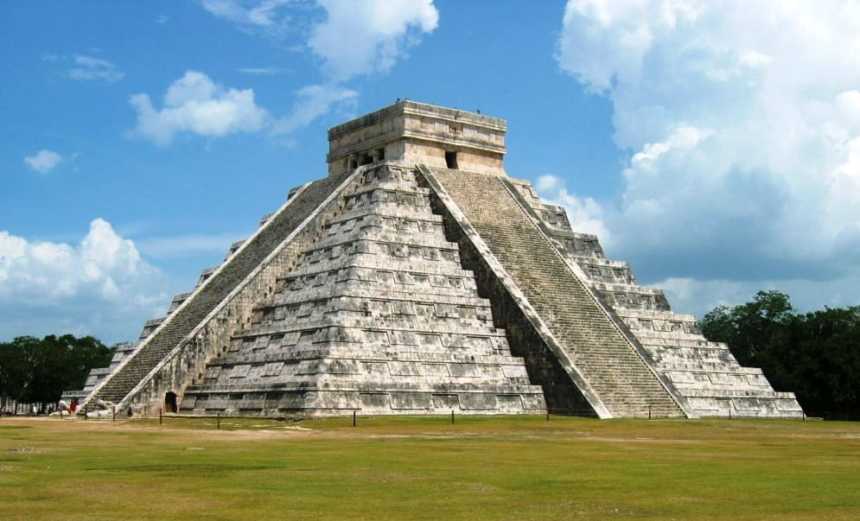
El Castillo is the nickname of one of the most spectacular Mayan temples that dominates the archaeological site of Chichen Itza, in the Yucatán state of present-day Mexico. The design of the step pyramid has special astronomical significance. Each face of the pyramid has a stairway with 91 steps, which together with the shared step at the top, add up to 365, the number of days in a year. A UNESCO World Heritage site, Chichen Itza is actually made up of two cities built by two peoples, the Mayas and the Toltecs. The site is made up of several surviving buildings including a circular observatory known as El Caracol, the Warriors’ Temple and El Castillo.
4. Ziggurat of Ur – Iraq
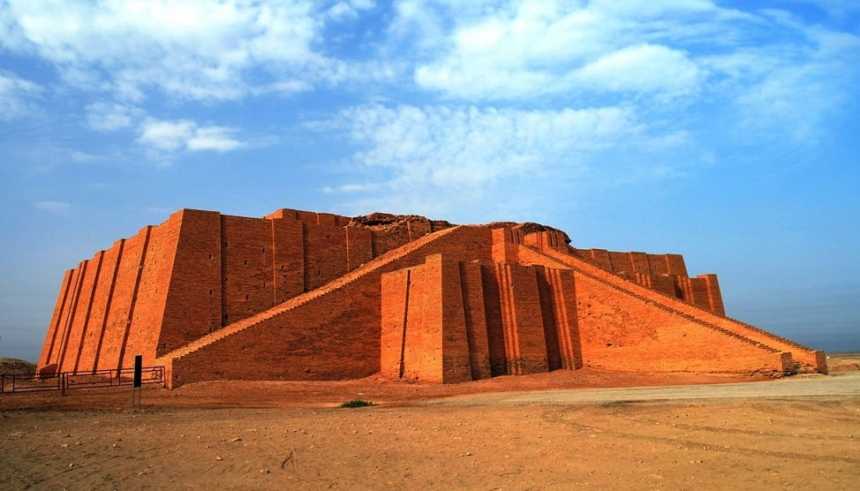
The ziggurat at the ancient city of Ur is one of the most well-preserved monuments of the Sumerians. Built for the Sumerian king Ur-Nammu in the mid-21st century B.C., once had three stories of terraced brick connected by staircases and topped with a shrine to a moon god. It eroded over time and was restored by the Babylonian king Nebuchadnezzar II in the 6th century B.C., then again by archaeologists in the 20th century. The massive step pyramid measured 64 m (210 ft) in length, 45 m (148 ft) in width and over 30 m (98 ft) in height. The structure would have been the highest point in the city by far and would have been visible for miles around, a focal point for travelers and the pious alike. The height is speculative, as only the foundations of the Sumerian ziggurat have survived. In antiquity, to visit the ziggurat at Ur was to seek both spiritual and physical nourishment.
5. Chaukhandi Stupa, Sarnath – India
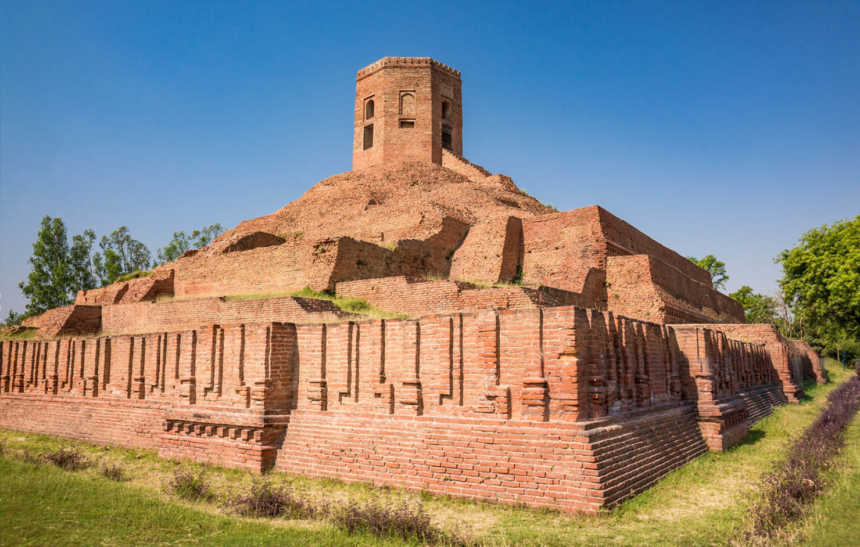
The stupa is an ancient Buddhist site which evolved from burial mounds and served as a shrine for a relic of Buddha. It appears to be in ruins and was originally constructed in 5th Century AD. It is widely belived that Stupa was originally built as a terraced temple during Gupta period (4th-6th centuries AD) to mark the site where the Buddha first met a group of five ascetics . Rectangular in shape, with steps leading upwards, it was decorated with sculptures of the Buddha. The octagonal structure right on top is an addition by a minister’s son during the Mughal period, in 1588 CE.
6. Pyramid of the Sun, Teotihuacan – Mexico
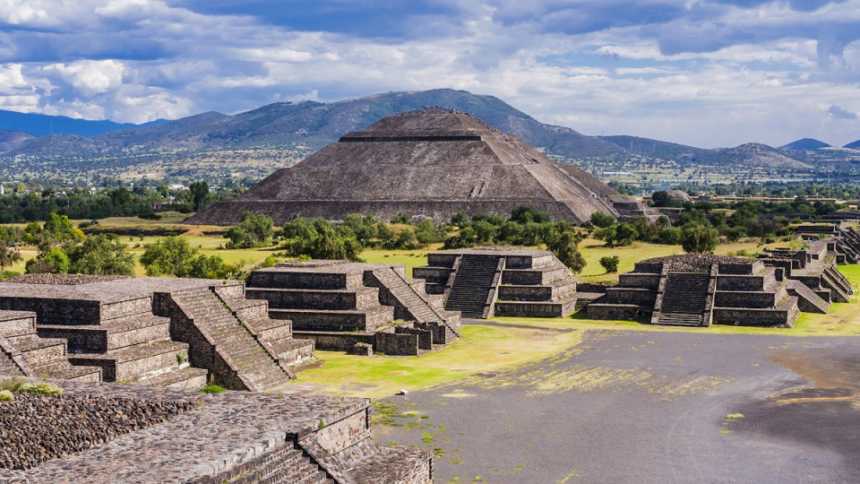
The Pyramid of the Sun is the largest building in Teotihuacán and one of the largest Pyramids in Mesoamerica. It measures 225m by 222m at its base and 75m high. The pyramid was constructed in two phases. The first construction stage, around 100 AD brought the pyramid to nearly the size it is today. The second round of construction resulted in its completed size of 225 meters (733 feet) across and 75 meters (246 feet) high. Made in a stepped style, the pyramid was originally painted over with lime plaster and brilliantly coloured murals. The structure had a temple on top at one point in time, and it is thought that it was used primarily for worship. The name comes from the Aztecs, who visited the city of Teotihuacán centuries after it was abandoned.
7. Pyramid of Djoser, Saqqara – Egypt
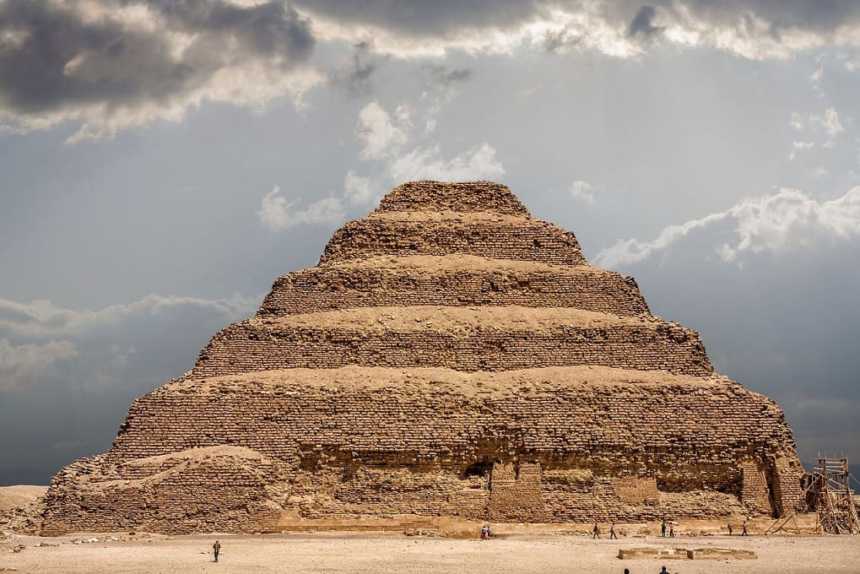
There are more than 100 pyramids in Egypt, but this was the first, built during the reign of Pharoah Djoser (2630 B.C. to 2611 B.C) as a grand mausoleum for himself. Previous pharaohs’ tombs were flat-topped mounds made mostly of mud, but Djoser’s chief architect, Imhotep, came up with a more durable and attractive idea: A “step pyramid” design, involving six successively smaller layers of carved limestone rising some 200 feet high. Imhotep, also a reputed healer, was later worshipped as a god of medicine in Greco-Roman culture.
8. Mayan Pyramids of Tikal – Guatemala
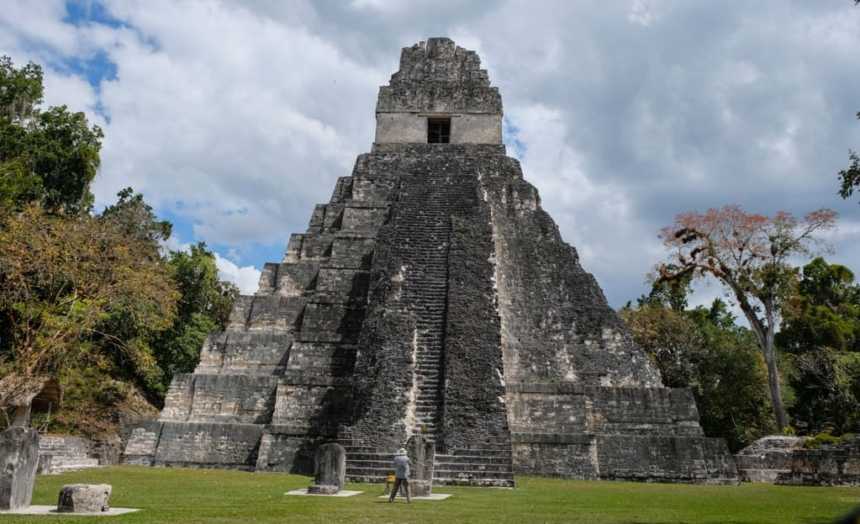
Situated in the lowland rainforest of northern Guatemala, Tikal is perhaps the most breathtaking of all the Mayan sites. This ancient city remained abandoned and out of sight in a rain forest for about 800 years after which it was discovered by explorers. Restored buildings are scattered around the area while many more ruined buildings are still hidden by the jungle. Between ca. 200 to 900 AD, Tikal was the largest Mayan city with an estimated population between 100,000 and 200,000 inhabitants. Tikal contains six very large step pyramids. The largest, Temple-pyramid IV, is some 72 meters (230 feet) high and was finished around 720 AD. Climbing to the top of one of these pyramids offers a great experience with beautiful panoramic views from above the tree tops.
9. The Nubian Pyramids – Sudan

The red sandstone pyramids of a region once known as Nubia, now in Central Sudan, were built about 800 years after their more famous Egyptian cousins. Similar in workmanship, the Nubian Pyramids are much smaller in size and greater in number. They were also built as tombs for the kings and queens of the region. Sudan probably has the greatest number of pyramids in any country around the world and about 40 of them are located in Meroe, a major city in the Kushite kingdom from about 300 B.C. to 300 A.D. Although they have suffered from plunder and decay over the years.
10. Brihadeeswarar Temple, Thanjavur – India

One of several remarkable Hindu temples built by the leaders of the Chola Empire, the Brihadisvara temple has a quite spectacular central pyramid structure. Built from 1003 to 1010 during the reign of Rajaraja I, the temple was constructed in honour of the Hindu deity Shiva. The temple is 240m long and 120m wide. There was no rock formation near the temple, so it had to be transported from quarries 50km away. It is believed the rock was brought to the building site by river boat. The temple tower incorporates the same building principles used in the construction of great pyramids of Giza.
11. Borobudur Temple, Java – Indonesia

Borobudur is countered the world’s largest Buddhist temple. Constructed in the ninth century, the massive structure is made up of nine stacked platforms, of which three are circular, and six are square. The platforms are topped by a massive central dome. Borobudur is decorated with as many as 2,672 relief panels and 504 Buddha statues. The total area occupied by the reliefs is 2,500 square meters (27,000 sq ft) and they are distributed in the hidden base (Kamadhatu) and Borobudur ‘s square platforms (Rupadhatu). The temple—essentially a variation of a step pyramid—is a sanctuary and place of Buddhist pilgrimage. This ancient pyramid temple is unique, and unlike other ancient temples which were built on a flat surface, Borobudur was constructed on a hill, 265 meters above sea level and 15 meters above the dry lake that surrounds it.
12. Pyramid of Cestius, Rome – Italy
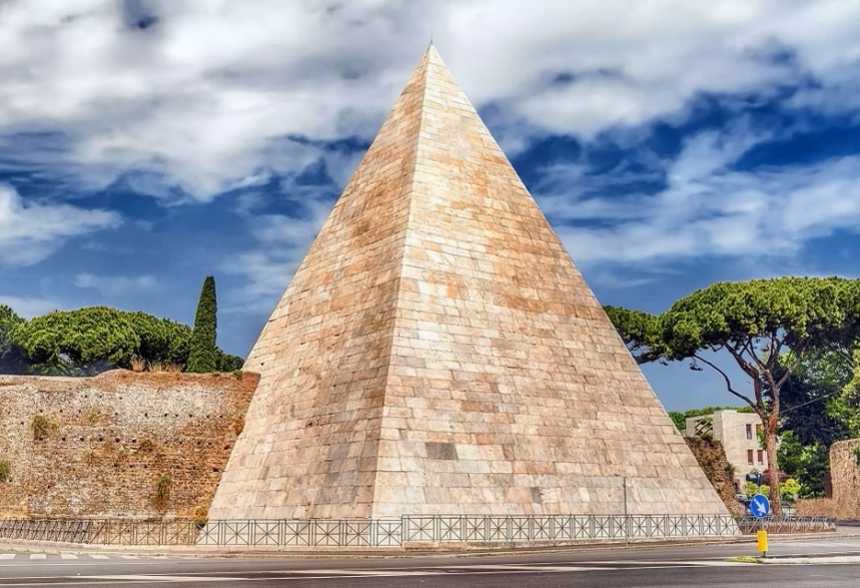
The Pyramid of Cestius is a truly unique Roman pyramid built as a tomb for the affluent magistrate Caius Cestius between 18 and 12 BC. Constructed of white marble and brick, this ostentatious 35-metre high tomb was likely built in this style due to the popularity of all things Egyptian which swept Rome after Egypt was incorporated into the Empire. Inside the tomb contained a number of frescoes depicting scenes from Roman mythology while an inscription still visible on the exterior gives details about its construction and dedication. This pyramid-tomb was later set into the Aurelian Walls, helping to ensure its preservation through the ages.
13. The Bent Pyramid, Dahshur – Egypt

Dahshur was once home to eleven Ancient Egyptian pyramids, of which few have survived. Just outside Cairo, this unique pyramid was built under Old Kingdom Pharaoh Sneferu. While the lower part rises from the desert at a 54-degree inclination, the top section is built at a shallower angle of 43 degrees. This leads to the obvious ‘bent’ appearance. Archaeologists believe that it was a transition between the earlier step pyramids to the later smooth-sided ones. The base of the pyramid is 188.6 meters (619 ft) and the height 101.1 meters (332 ft). It is also the only Egyptian pyramid to retain its original polished limestone outer casing.
14. Pyramid of Calakmul, Campeche – Mexico
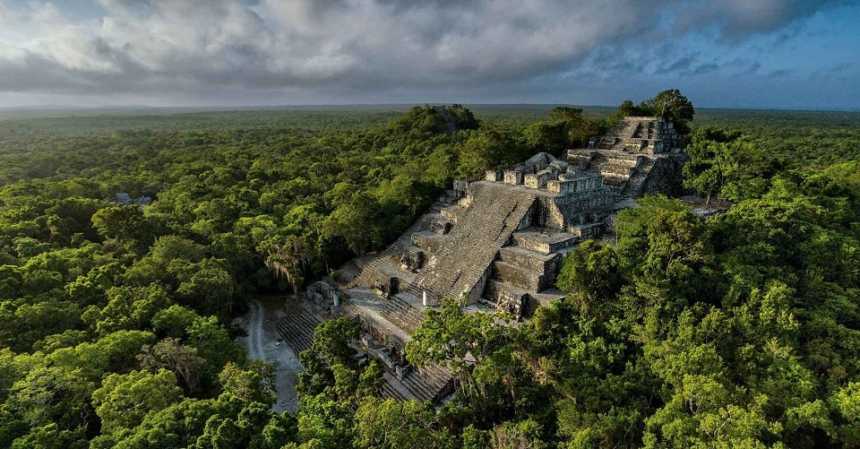
Calakmul is a remote and incredible Maya site in Campeche, Mexico, containing the remains of a vast and once-powerful ancient city. It is one of the largest Mayan cities ever uncovered with over 6,500 ancient structures identified. Among the many interesting structures found there are two gigantic pyramids — with the largest one reaching 55 meters high (165 feet). The Great Pyramid has a base covering 5 acres and rises 174 ft. – making it both the tallest pyramid in the Yucatan and the largest structure yet discovered in the Mayan world. Like many other temples in Mesoamerica the Mayans increased the size of the pyramid at Calakmul by building upon an older existing temple to reach its current size.
15. Mausoleum of the First Qin Emperor, China
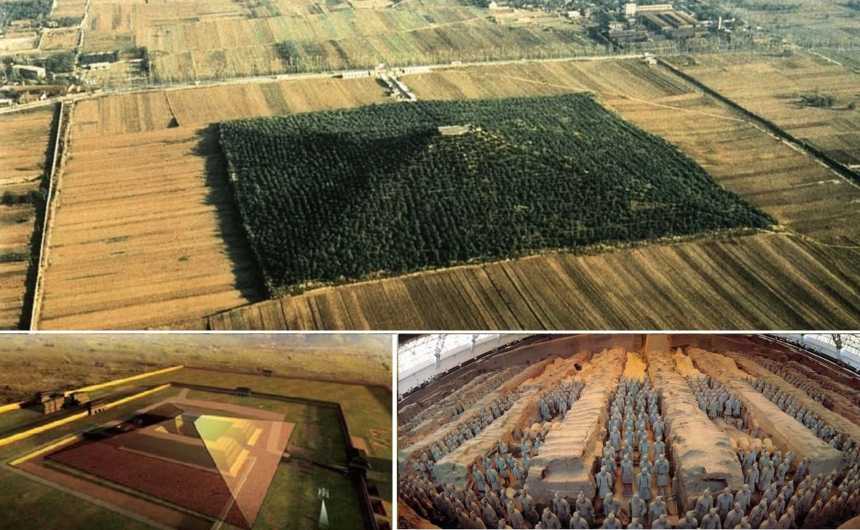
The pyramid houses Emporer Qin Shi Huang’s tombs, who united China’s six warring states into one “country” and then died in 210 BC. This incredible tomb was accidentally stumbled upon by two men digging a well who found the Terra Cotta warriors. This is one of the only parts of the tomb to be uncovered, as the mound itself remains intact. According to scientists, we don’t quite have the technology to safely penetrate the actual tomb, and it’s rumored to have rivers of murcery flowing around an underground palace with ceilings decorated like the sky and all the opulance an emporer would need in the afterlife. Nearly 200 accompanying pits containing thousands of life-size terra cotta soldiers, terra cotta horses and bronze chariots and weapons together with burial tombs and architectural remains total over 600 sites within the property area of 56.25 square kilometers.
16. Prang Temple, Koh Ker – Cambodia
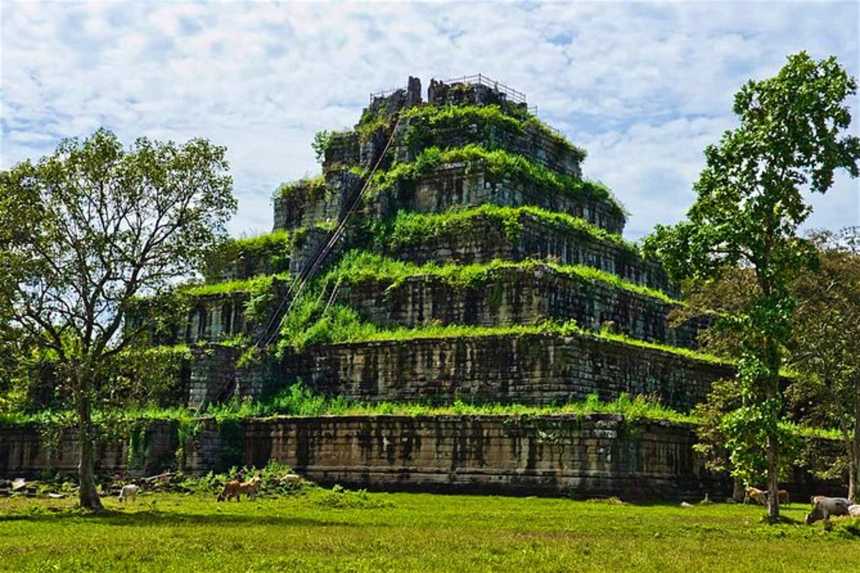
Once the ancient capital of Cambodia, Koh Ker was home to almost 100 temples, most of which are still standing. Built under the reign of Jayavarman IV, the seven‑tiered and 118-foot-tall pyramid is truly unparalleled. However, very few of its beautiful sculptures are left at the site, having either been looted over the years, or placed in museums by the government.
17. Chogha Zanbil, Khuzestan – Iran
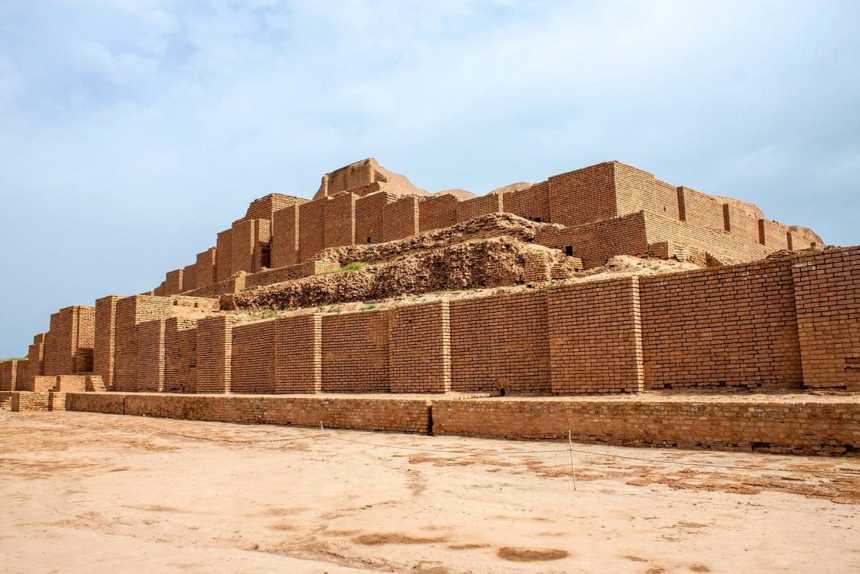
One of a handful of surviving Mesopotamian ziggurats and a crucial entry on any list of pyramids of the world, Tchogha Zanbil forms part of the remains of the ancient city of Dur Untash, the holy capital of the Elamite Kingdom. The undeniable focal point of the ruins of Tchogha Zanbil is one of the greatest – if not in fact the greatest – ziggurats to have been built in Mesopotamia. Originally a temple dedicated to the deity Inshushinak, it developed to become the ornate pyramid-like structure – ziggurat – that stands today, although at 25 metres high it is now just a shadow of its former self having once risen to 60 metres.
18. Tomb of the General, Ji’an – China

The Tomb of the General is the burial tomb of King Jangsu, the 20th monarch of Goguryeo, the northernmost of the Three Kingdoms of Korea. King Jangsu became king at the age of 19 in 413 AD and reigned over Goguryeo until his death in 491 AD. During his reign, Goguryeo was at its golden age, stretching from Mongolia to Chungju. Known as the Pyramid of the East, his tomb measures 31 meters (102 ft) on each side and stands 13 meters (43 ft) high. The step pyramid is located in Ji’an in China, a former capital of Goguryeo.
19. Pyramid of the Niches, El Tajin – Mexico
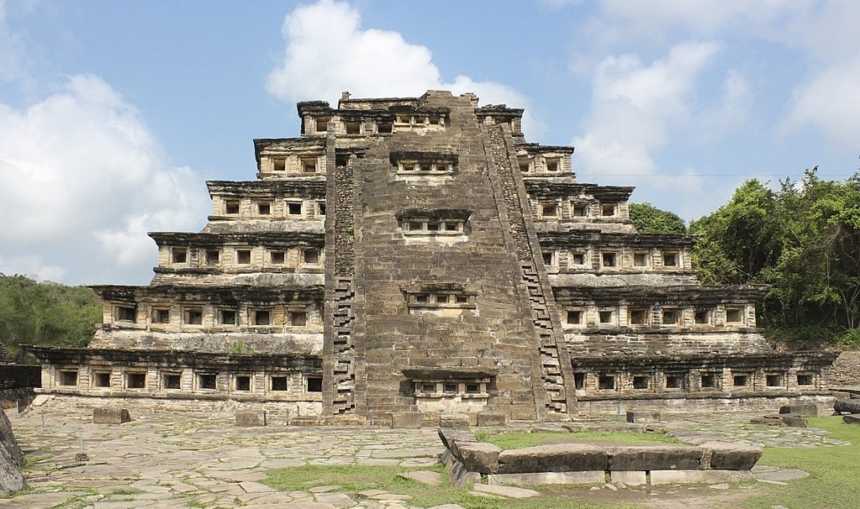
El Tajín was an important gulf coast city in present-day Mexico, founded by the Classic Veracruz culture. Most of the buildings at the site were constructed between 600 – 900 AD. An awe inspiring collection of ancient pyramids can be seen at El Tajin in Mexico, particularly the Pyramid of the Niches, a grand pyramid which stretches seven stories high and would have once been topped by a temple. The pyramid’s design is unique in the Americas and rises 20 meters (66 ft) with a wide staircase at its eastern side. Today the pyramid is still incredibly well preserved and everything from the intricately designed structure to the magnificent stone tablets attract thousands of tourists each year.
20. Candi Sukuh, Java – Indonesia
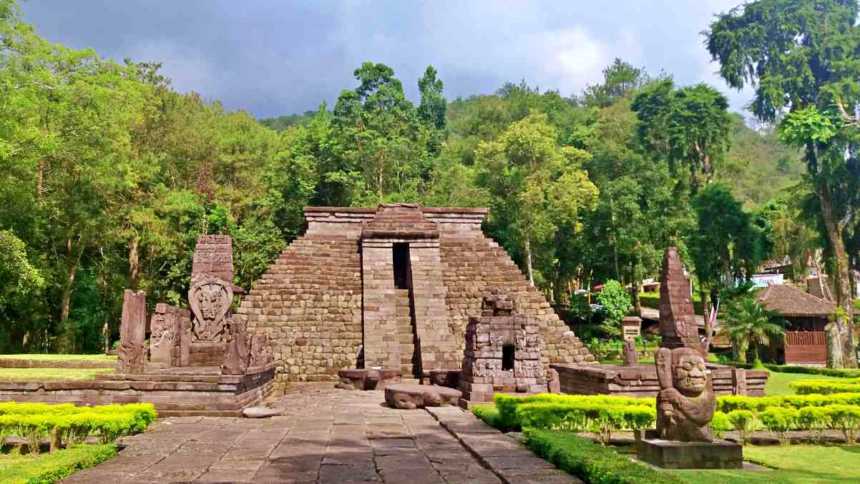
Candi Sukuh is a 15th century Hindu temple that is located on the western slope of Mount Lawu in Central Java, Indonesia. The centerpiece of Candi Sukuh is a truncated pyramid that sits on the third terrace of the complex. It’s surrounded by smaller structures with bas-reliefs and several statues, all directly or indirectly related to birth and sex. A six-foot-tall phallus accompanied by four testes once topped the pyramid, but that has been relocated to the National Museum of Indonesia in Jakarta. The temple of Candi Sukuh differs completely from other Javanese Hindu and Buddhist temples and is curiously Maya-like.
21. The Huaca Pucllana, Lima – Peru
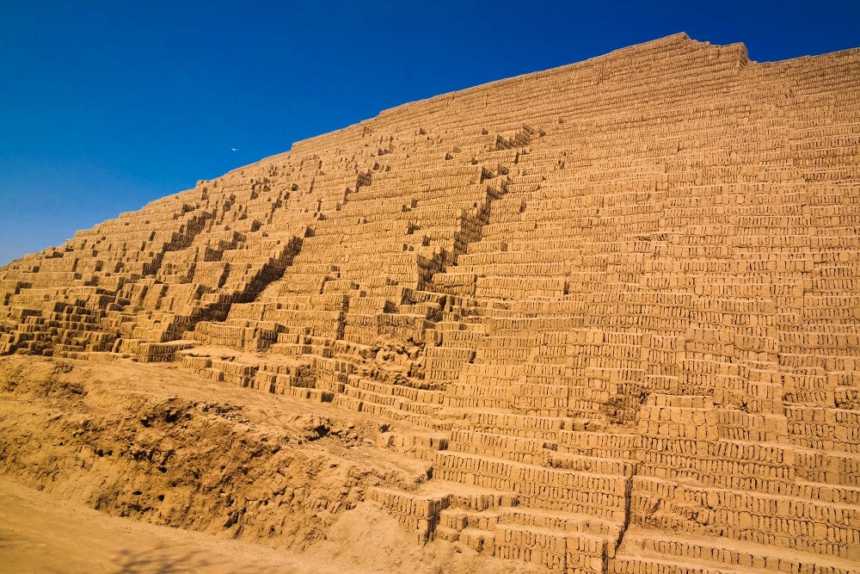
The Huaca Pucllana is a stepped structure with several large courtyards at different levels that are accessed through zigzagging ramps and long corridors. Huaca Pucllana, much smaller in size compared to the Great Pyramid of Giza was nonetheless a tremendous engineering feat of ancient times. Dating from 5th century, the pyramid served as an important ceremonial temple and administrative center for the various cultures which prospered in the Lima region before the arrival of the Spanish conquistadors. The city was once home to around 40 pyramids which were destroyed throughout history and as the population expanded.
22. Pyramid of Cholula, Puebla – Mexico
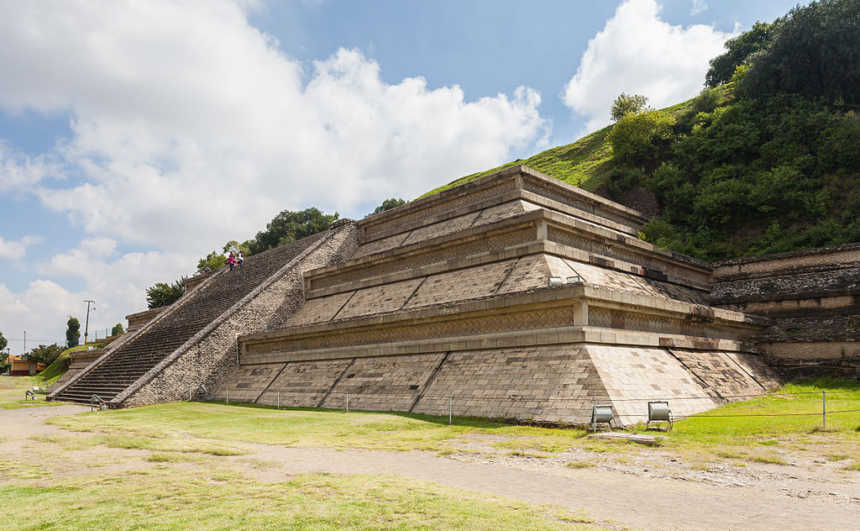
What looks like a grassy hill in the modern Mexican state of Puebla is actually one of the world’s largest ancient monuments, a pyramidal complex covering nearly 45 acres and rising 177 feet high. Its formal name is Tlachihualtepetl, but many people simply call it the Great Pyramid of Cholula. It was built in stages by pre-Columbian people and was once used by the Aztecs as a temple to their god Quetzalcoatl. After the city’s conquest by Spanish colonizers in the 16th century, a Catholic church was erected on the top of the grass-covered pyramid.
23. Akapana Pyramid, Tiwanaku – Bolivia

Tiwanaku, found on the southern shore of Lake Titicaca in Bolivia, was the capital city of one of the most important civilizations to exist from approximately A.D. 500 to 950 A.D. One of the most interesting structures is the Akapana pyramid. It was one of the largest constructions at Tiwanaku, and probably the principal sacred area in the city. The nearly 60 foot tall Akapana platform pyramid looks like a regular hill except for the portions of walls, columns and stones sticking out of it. Plundered through the centuries for its stones, it seems the pyramid was never finished when it was first constructed.
24. Monte d’Accoddi, Sardina – Italy
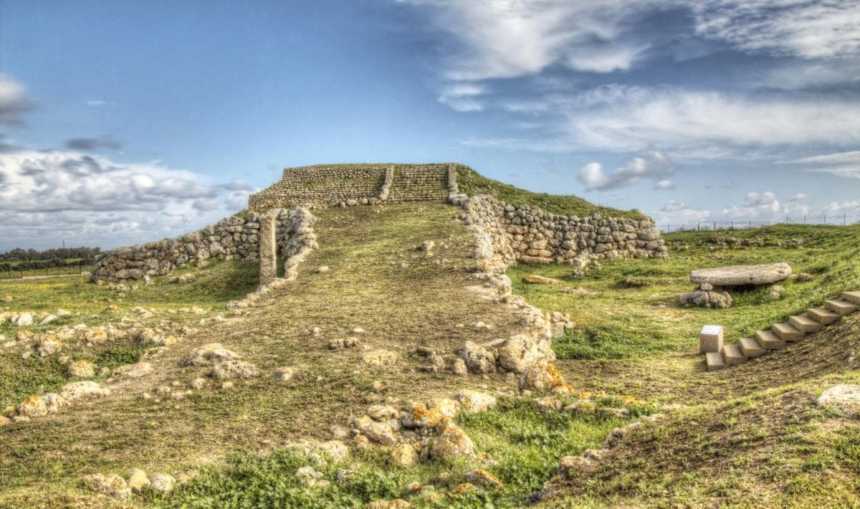
Monte d’Accoddi is an ancient megalithic structure in northern Sardinia, Italy and dates from around c. 4,000-3,650 BCE. The structure was initially built by the Ozieri culture, a prehistoric pre-Nuragic civilisation that constructed more than 200 related archaeological sites. The pyramid is believed to be the earliest known sacrificial site in Western Europe, evident by the trace remains of sheep, cattle and swine in the chalcolithic Abealzu-Filigosa layers. It was discovered in the mid-20th century.
25. Ahichhatra, Bareilly – India

Ahichhatra was ancient capital of North Panchala, a kingdom mentioned in Mahabharata. Discovered in 1871, Ahichhatra was excavated in 1940. The excavations have brought to life a giant ancient temple in form of a large pyramid and continuity of occupation from a period before 600 BCE to 1100 CE.

